Mitsuyo Maeda nicknamed Count Koma was born in 1878. He excelled in Ju-Jitsu, think of it as a combination of the striking arts of karate with the grapples and throws of Judo. On tour he presented an exhibition of Ju-Jitsu in Brazil, the year was 1914. He toured the Americas for months and returned to Brazil a few years later. He beat boxers and wrestlers from different nations in the contests, he came right on the heels of Yuanjia, making the two men some of the first documented champions of mixed martial arts encounters.
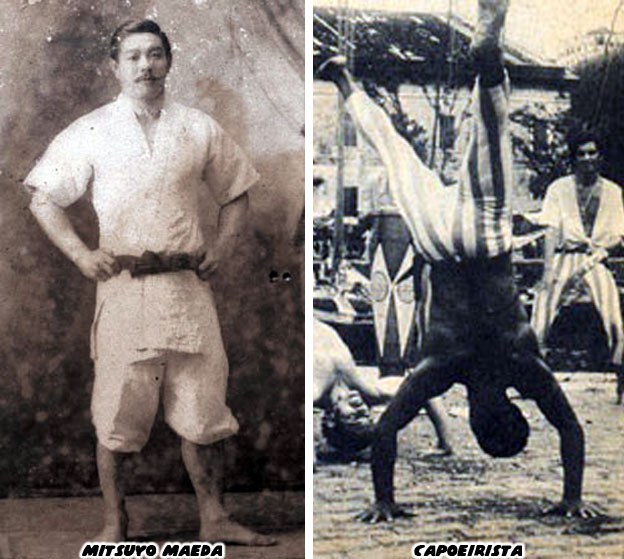
When Kouma was in Brazil in 1919 a fight was arranged against Capoeirista Pé de Bola. Capoeira was a fighting form that was adapted by African slaves and hidden from the masters in the form of a dance. The Brazilians were proud of this fighting form, especially since it survived centuries of oppression during the slave years. There was a stipulation against Count Kouma, his opponent would be allowed to use a knife in the fight. Some of the more dangerous capoeira fights, those using knives and razors were called maculele. They were loosely derived from ancient Angolan knife fighting. Kouma won the fight and earned the admiration of the Brazilians. In 1916 Gastao Gracie was a business partner that had Maeda perform demonstrations as part of a circus side show, his son Carlos Gracie became his student, the techniques were passed down to brothers Osvaldo, Jorge and Helio.
While it could not be considered an early MMA tournament the jujitsu battle between Masahiko Kimura of Japan and Helio Gracie was a turning point in the history of the martial arts. Helio was like a God to grapplers. Born in 1913 the Brazilian was the youngest of five brothers and learned to fight early on. He had a natural acclimation to judo and jujitsu and began teaching at a young age. Helio and his brother Carlos founded the Gracie school of Ju-jitsu or as the rest of the world calls the system Brazilian Ju-jitsu (BJJ). Count Kouma was a defining factor in the form but many Japanese immigrants had brought with them many traditions from overseas and the Brazilians were eager to learn more about the martial arts. Helio was the tallest of his brothers but very thin. Many judo throws and jujitsu submission moves relied on strength and mass. Helio had little of both but learned ways to make the form work for him. He began modifying the traditional hand, hip and leg positions to generate the maximum amount of leverage with the minimum amount of force. He excelled at escaping and counter attacks. Helio began holding his own in tournaments and even defeating opponents that were well above his weight class. He had defeated many Japanese judo practitioners and other martial artists in his career. In 1951 he had two of the most famous matches of his career and one of the few that he had ever lost.
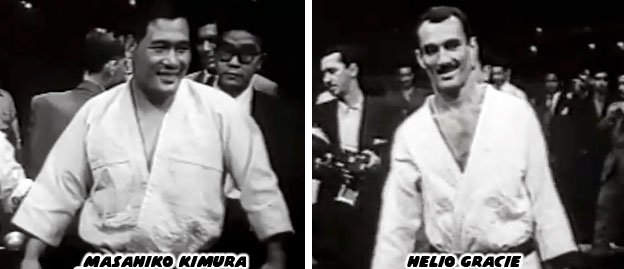
The first fight was against a jujitsu specialist known as Kato. Helio had openly challenged the Japanese champion Masahiko Kimura to a match but Kimura deferred. Saying that Kato would be more than a match for him and would beat him easily. fight lasted less than ten minutes and ended with Kato being choked unconscious. Kimura could no longer assume that Japan had any superiority when it came to the fighting arts. The match against Helio took place 23 days later. Although the two were fighting in the same "style" the techniques exploited by both were very different. The "victor" would turn out to be the one that could adapt to his opponent. It was the same lesson that would turn great fighters into legends. People like Mas Oyama and Bruce Lee were by no stretch of the imagination the first to try their style against other established forms.
When the contest started Kimura wasted no time threw the smaller Helio on the mat again and again, hoping to knock him out in the process. Since they were fighting on padded ground that never happened. If the contest were using a traditional scoring system then Kimura would have won on points alone. But this was a different contest, one designed to see who could get the other to into a submission move. Even then Kimura said that if Helio could last longer than three minutes then he should be declared the winner. Helio managed to elude hold after hold but was eventually caught by an arm bar. Helio refused to tap out and had his arm broken in the process. Kimura kept the pressure on hoping to make him submit but he did not relent. Helio's brother and business partner Carlos threw in the towel to end the match. Even in defeat Helio became an icon to the Brazilian people. He was talented, defiant, tenacious and had an unbreakable spirit. Essentially he was like a real-life grappling Rocky Balboa. The Gracie family name would rise following the battle and members of which would go on to capture regional, national and international championships. the schools they established help produce champions on every corner of the Earth.
In North America judo and jujitsu were becoming well known through the '30s and '40s. Film and television had exposed the mainstream to the secretive fighting arts of the "ancient orient." In many early representations the Asian arts were often seen as people swinging their arms with broad open-hand chops, this was absurd but worked for audiences. More than two decades before Bruce Lee would rewrite martial arts cinema there were some actors in Hollywood that got the importance of knowing and respecting the actual fighting arts. James Cagney was one of those people and it showed. He had few memorable battles highlighting various judo throws and submission moves in the movie Blood on the Sun. He played Nick Condon a newspaper editor working in Japan just before the onset of WWII. The 1945 movie a won an Academy Award for best art direction for a black and white film. Fans of the fight game in North America were interested in how well the Eastern fighting arts would hold up against the sweet science of boxing. In 1963 pro wrestler "Judo" Gene Lebell fought boxer Milo Savage. Although their fight took place a decade after Oyama had beaten kung-fu and muay thai masters on their home turf the Lebell / Savage fight would be considered another major milestone. It was the first filmed MMA encounter in the US, if not the world. Remember that Bruce Lee fought Wong Jack Man a year later in San Francisco! The US was still learning the nuances between Japanese and Chinese fighting arts and an explosion in popularity was steadily building.
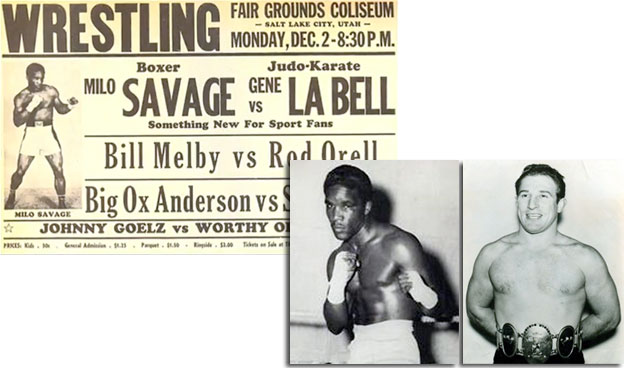
Speaking of Lee, Lebell was a stuntman on the Green Hornet and eventually befriended the actor. The two traded moves at Labell's gym for the better part of a year. Labell learning Lee's strikes and Lee picking up the wrestling and submission moves in return. There was some controversy doing the Labell and Savage fight. Special rules had to be drafted to ensure the fight was more fair for both parties. Savage was allowed to wear speed gloves rather than boxing gloves, the lighter gloves were capable of doing more damage if they connected. But he also had to wear a gi top so the grapples could be applied. Labell was not allowed to use kicks but only traditional grabs and throws. It was said that Savage knew some wrestling moves so he could be able to break holds. Not only that but there was possibly some metal within his speed gloves so he could seriously damage Labell. The fight lasted four rounds and Labell won by choking out Savage. After the fight Labell did not claim it was one particular style that won. In Black Belt Magazine he said "I represented all the martial arts. I never said I was doing only judo or karate or kenpo. I never said one art is better than the others. They're all good. You should learn everything. You're not a complete martial artist unless you do everything."
The reputation that Labell had as a genuine fighter followed him through most of his career. In 1976 there would be a rematch of sorts between a boxer and wrestler. Labell was invited to be the referee. The two men that fought this time were very high profile athletes. The Japanese superstar and founder of New Japan Pro Wrestling Antonio Inoki would be facing the incomparable Muhammad Ali. The fight was scheduled to be one for the ages. Unfortunately there were many challenges in agreeing to the format and rules. Ali was a huge fan of wrestling and had been raised on a steady diet of pro wrestling while growing up. The flamboyant attitude he sported and outlandish microphone skills were undoubtedly influenced by the wrestlers he had seen on television and in person as a boy. Unfortunately a stand up fight with wrestling rules would have put Ali at a disadvantage. There was no way for him to break out of holds with boxing gloves on.
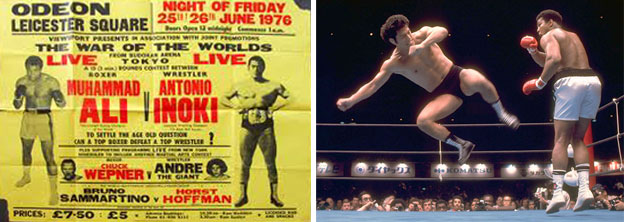
Stipulations were placed on Anoki from the get-go. He was not allowed to throw punches or elbows at Ali, nor was he allowed to grapple with him. Even though the two knew it was a "work" or not a full-out battle so that neither man would be seriously hurt they still wanted to put on a good show. The downside was that there was little for Inoki to do as a student of both wrestling and karate. He resorted to throwing drop kicks and lying on his back kicking at Ali through most of the match. The bout ended as a draw much to the chagrin of those in attendance. It was not much of a show for spectators but those in the martial arts knew the significance of this encounter. Ali lent his name to help raise the legitimacy of wrestling as one of the martial arts as well. In return he ended up going to the hospital because of the massive bruises that Inoki had left him with. Doctors were afraid that Ali might get a blog clot and suffer a stroke or heart attack from the ordeal.
Before Count Kouma, before the "Greatest of All Time" the fighting arts had been subject to vigorous debate. Which was the best form and who was the best fighter that ever lived? That debate lives on today through heated internet forum debates, television analysis and even video game reenactments. Those that studied the martial arts, like Labell knew that there was not one superior school, simply ones that had strengths in particular areas. It did not stop fighters from trying to show that they and their style was the best. Television and news stories on these fighters would help spread the word all around the world. The next blog will compare how the mixed martial arts evolved in Japan and the Americas. As always if you enjoyed this blog and would like to sponsor me please visit my Patreon page and consider donating each month, even as little as $1 would help make better blogs and even podcasts!
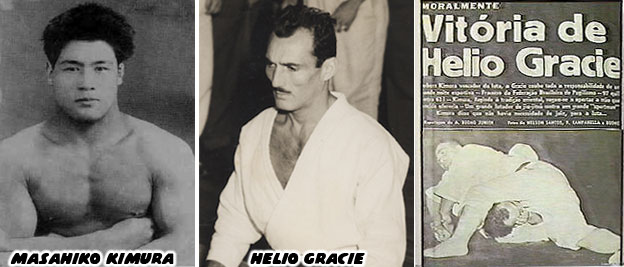

No comments:
Post a Comment